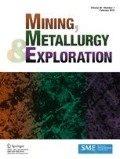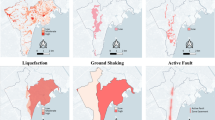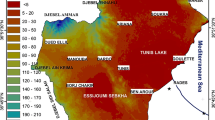Abstract
Optimizing final pit limits for stochastic models provides access to geologic and economic uncertainty in the pit optimization stages of a mining project. This paper presents an approach for optimizing final pit limits for a highly variable and geologically complex gold deposit. A heuristic pit optimizer is used to manage the effect of geological uncertainty in the resources within a pit shell with multiple uncertainty rated solutions. The uncertainty rated pit shells follow the mean-variance criterion to approximate the efficient frontier for final pit limits. Stochastic dominance rules are then used in a risk management framework to further eliminate sub-optimal solutions along the efficient frontier. This results in a smaller set of final pit shells that could be further analyzed for production scheduling. Additionally, the original solutions are analyzed for changes in the mining limits and two regions are targeted as potential regions for further exploration.















Similar content being viewed by others
References
Abdel Sabour Sa, Dimitrakopoulos RG, Kumral M (2008) Mine design selection under uncertainty. Mining Technology : IMM Transactions section A 117(2):53–64. https://doi.org/10.1179/174328608X343065
Acorn T, Deutsch CV (2018) Optimizing pit shells in the presence of geologic uncertainty with a heuristic algorithm. Society of Mining, Mettalurgical, and Exploration Annual Transactions
Carlson TR, Erickson JD, O’Brain DT, Pana MT (1966) Computer techniques in mine planning. Min Eng 18(5):53–56
Deutsch CV, Gegg SH (2001) How many realizations do we need? Tech. rep. University of Alberta, Edmonton AB
Deutsch M, Gonzales E, Williams M (2015) Using simulation to quantify uncertainty in ultimate-pit limits and inform infrastructure placement. Min Eng 67(December):49–55
Elahi E, Kakaie R, Yusefi A (2012) A new algorithm for optimum open pit design: floating cone method III. J Min Env 2(2):118–125. https://doi.org/10.22044/jme.2012.63
Gallardo E, Deutsch C (2017) Active geological risk management case study: vertical placement of well pairs in SAGD. Centre for Computational Geostatistics Annual Report 19
Gallardo E, Deutsch C (2017) A decision-making model for active geological risk mangement (AGRM) in petroleum reservoir operations. Centre for Computational Geostatistics Annual Report 19
Goldberg A, Tarjan R (1988) A new approach to the maximum-flow problem. J ACM 35:921–940
Goodfellow RC, Dimitrakopoulos R (2015) Global optimization of open pit mining complexes with uncertainty. Appl Soft Comput 40:292–304. https://doi.org/10.1016/j.asoc.2015.11.038
Hochbaum D (2008) The pseudoflow algorithm: a new algorithm for the maximum-flow problem. Oper Res 58(4):982–1009
Hustrulid WA, Kuchta M (2013) Open pit mine, 3rd edn. Taylor and Francis, London
Johnstone D, Lindley D (2013) Mean-variance and expected utility: the Borch paradox. Stat Sci 28 (2):223–237
Journel AG (2007) Roadblocks to the evaluation of ore reserves - the simulation overpass and putting more geology into numerical models of deposits. Australasian Institute of Mining and Metallurgy 14:29–32
Koushavand B, Askari-Nasab H, Deutsch CV (2014) A linear programming model for long-term mine planning in the presence of grade uncertainty and a stockpile. Int J Min Sci Technol 24:451–459. https://doi.org/10.1016/j.ijmst.2014.05.006
Lerchs H, Grossmann IF (1965) Optimum design of open pit mines. Canadian Institute of Mining Transactions 68:17–24
Levy H (2016) Stochastic dominance: investment decision making under uncertainty, vol. 1, 3rd Edn Springer. https://doi.org/10.1007/978-3-319-21708-6
Levy H, Sarnat M (2015) Portfolio selection and investors utility: a graphical analysis. Appl Econ 2:113–119
Marcotte D, Caron J (2013) Ultimate open pit stochastic optimization. Comput Geosci 51:238–246. https://doi.org/10.1016/j.cageo.2012.08.008
Markowitz H (1952) Portfolio selection*. The Journal of Finance 7(1):77–91. https://doi.org/10.1111/j.1540-6261.1952.tb01525.x
Martin R, Machuca-Mory D, Leuangthong O, Boisvert JB (2018) Non-stationary geostatistical modeling: a case study comparing LVA estimation frameworks Natural Resources Research. https://doi.org/10.1007/s11053-018-9384-5
Rahmanpour M, Osanloo M (2016) Resilient decision making in open pit short-term production planning in presence of geologic uncertainty. Int J Eng 29(7):1022–1028. https://doi.org/10.5829/idosi.ije.2016.29.07a.18
Rossi ME, Deutsch CV (2013) Mineral resource estimation, chap. 10, 12. Springer, Netherlands
Silva DSF, Boisvert JB (2013) Mineral resource classification (NI 43 - 101): an overview and a new evaluation technique. Centre for Computational Geostatistics Annual Report 15
SRK Consulting (2014) (United Kingdom) Inc.: Prepared for Golden Star Resources Ltd, NI 43-101 technical report on a feasibility study of the Wassa open pit mine and undergroud project in Ghana, Africa, dated December 31, 2014
Walls MR (2005) Corporate risk-taking and performance: a 20 year look at the petroleum industry. J Pet Sci Eng 48(3-4):127–140. https://doi.org/10.1016/j.petrol.2005.06.009
Walls MR (2005) Measuring and utilizing corporate risk tolerance to improve investment decision making. Eng Econ 50(4):361–376. https://doi.org/10.1080/00137910500348434
Acknowledgments
We would like to thank SRK Consulting and Golden Star Resource Ltd. for providing data and support for this study. We would also like to thank Ryan Martin for the input he provided on the stochastic models used in this study.
Funding
This project was funded through the ENGAGE grant from the National Sciences and Engineering Research Council of Canada.
Author information
Authors and Affiliations
Corresponding author
Ethics declarations
Conflict of Interest
The authors declare that they have no conflict of interest.
Additional information
Publisher’s Note
Springer Nature remains neutral with regard to jurisdictional claims in published maps and institutional affiliations.
Rights and permissions
About this article
Cite this article
Acorn, T., Boisvert, J.B. & Leuangthong, O. Managing Geologic Uncertainty in Pit Shell Optimization Using a Heuristic Algorithm and Stochastic Dominance. Mining, Metallurgy & Exploration 37, 375–386 (2020). https://doi.org/10.1007/s42461-019-00165-w
Received:
Accepted:
Published:
Issue Date:
DOI: https://doi.org/10.1007/s42461-019-00165-w




